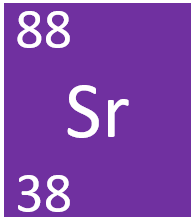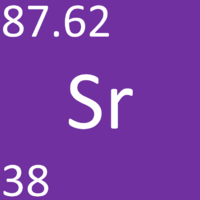Difference between revisions of "Strontium"
| (3 intermediate revisions by the same user not shown) | |||
| Line 4: | Line 4: | ||
==Key Stage 3== | ==Key Stage 3== | ||
===Meaning=== | ===Meaning=== | ||
| − | [[File: | + | [[File:StrontiumSymbol1.png|right|300px|thumb|The [[Chemical Symbol|chemical symbol]] for [[Strontium]].]] |
[[Strontium]] is a [[Group 2]] [[element]], on the [[Periodic Table]], with an [[Atomic Number|atomic number]] of 38. | [[Strontium]] is a [[Group 2]] [[element]], on the [[Periodic Table]], with an [[Atomic Number|atomic number]] of 38. | ||
===About Strontium=== | ===About Strontium=== | ||
| Line 20: | Line 20: | ||
==Key Stage 4== | ==Key Stage 4== | ||
| + | [[File:SrKS4.PNG|right|200px|thumb|The [[Chemical Symbol|chemical symbol]] for [[Strontium]].]] | ||
===Meaning=== | ===Meaning=== | ||
[[Strontium]] is a [[Group 2]] [[element]], on the [[Periodic Table]], with 38 [[proton]]s in the [[Atomic Nucleus|nucleus]]. | [[Strontium]] is a [[Group 2]] [[element]], on the [[Periodic Table]], with 38 [[proton]]s in the [[Atomic Nucleus|nucleus]]. | ||
===About Strontium=== | ===About Strontium=== | ||
====Molecular Structure==== | ====Molecular Structure==== | ||
| − | : [[Strontium]] has the [[Chemical | + | : [[Strontium]] has the [[Chemical Symbol|chemical symbol]] [[Strontium|Sr]]. |
: [[Strontium]] [[atom]]s join together in a [[Giant Metallic Structure|giant metallic structure]]. | : [[Strontium]] [[atom]]s join together in a [[Giant Metallic Structure|giant metallic structure]]. | ||
| + | |||
====Atomic Structure==== | ====Atomic Structure==== | ||
: The most [[Stable Isotope|stable isotope]] of [[Strontium]] has 50 [[neutron]]s in its [[Atomic Nucleus|nucleus]] giving it an [[Relative Atomic Mass|atomic mass]] of 88. | : The most [[Stable Isotope|stable isotope]] of [[Strontium]] has 50 [[neutron]]s in its [[Atomic Nucleus|nucleus]] giving it an [[Relative Atomic Mass|atomic mass]] of 88. | ||
: An [[atom]] of [[Strontium]] has only 2 [[electron]]s in its [[Outer Shell|outer shell]]. | : An [[atom]] of [[Strontium]] has only 2 [[electron]]s in its [[Outer Shell|outer shell]]. | ||
| − | : [[Strontium]] [[ion]]s have lost two [[electron]]s to become [[Positive | + | : [[Strontium]] [[ion]]s have lost two [[electron]]s to become [[Positive Charge|positively charged]]. |
====Properties==== | ====Properties==== | ||
: [[Strontium]] is a more [[Reactivity|reactive]] [[Alkali Earth Metal|alkali earth metal]] than [[Calcium]] but less [[Reactivity|reactive]] than [[Barium]]. | : [[Strontium]] is a more [[Reactivity|reactive]] [[Alkali Earth Metal|alkali earth metal]] than [[Calcium]] but less [[Reactivity|reactive]] than [[Barium]]. | ||
Latest revision as of 11:19, 5 March 2020
Contents
Key Stage 2
Meaning
Key Stage 3
Meaning
Strontium is a Group 2 element, on the Periodic Table, with an atomic number of 38.
About Strontium
Molecular Structure
- Strontium has the chemical symbol Sr.
- Strontium atoms join together in large numbers to form a giant metal molecule.
Atomic Structure
- Strontium as 38 protons and 50 neutrons in its nucleus giving it an Atomic Number of 38 and an atomic mass of 88.
- An atom of Strontium has only 2 electrons in its outer shell.
Properties
- Strontium is a more reactive alkali earth metal than Calcium but less reactive than Barium.
- Strontium is more reactive than Carbon on the reactivity series so it must be extracted from its ore using electrolysis.
- Strontium reacts strongly with water to produce Hydrogen gas and Strontium Hydroxide and strongly with acid to produce Strontium salts.
- Strontium is a solid at room temperature.
Key Stage 4
Meaning
Strontium is a Group 2 element, on the Periodic Table, with 38 protons in the nucleus.
About Strontium
Molecular Structure
- Strontium has the chemical symbol Sr.
- Strontium atoms join together in a giant metallic structure.
Atomic Structure
- The most stable isotope of Strontium has 50 neutrons in its nucleus giving it an atomic mass of 88.
- An atom of Strontium has only 2 electrons in its outer shell.
- Strontium ions have lost two electrons to become positively charged.
Properties
- Strontium is a more reactive alkali earth metal than Calcium but less reactive than Barium.
- Strontium is more reactive than Carbon on the reactivity series so it must be extracted from its ore using electrolysis.
- Strontium reacts strongly with water to produce Hydrogen gas and Strontium Hydroxide and strongly with acid to produce Strontium salts.
- Strontium is a solid at standard temperature and pressure.

